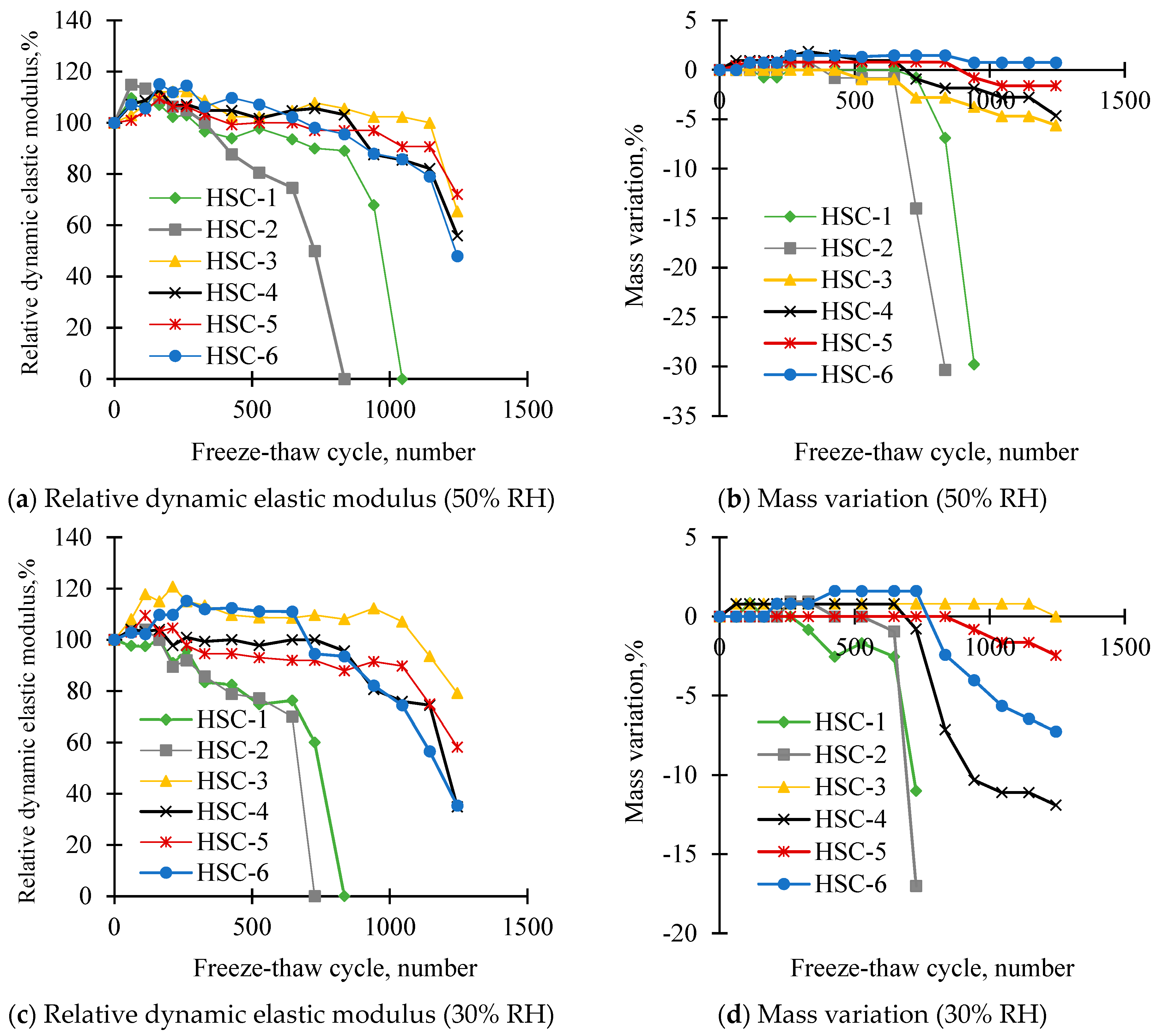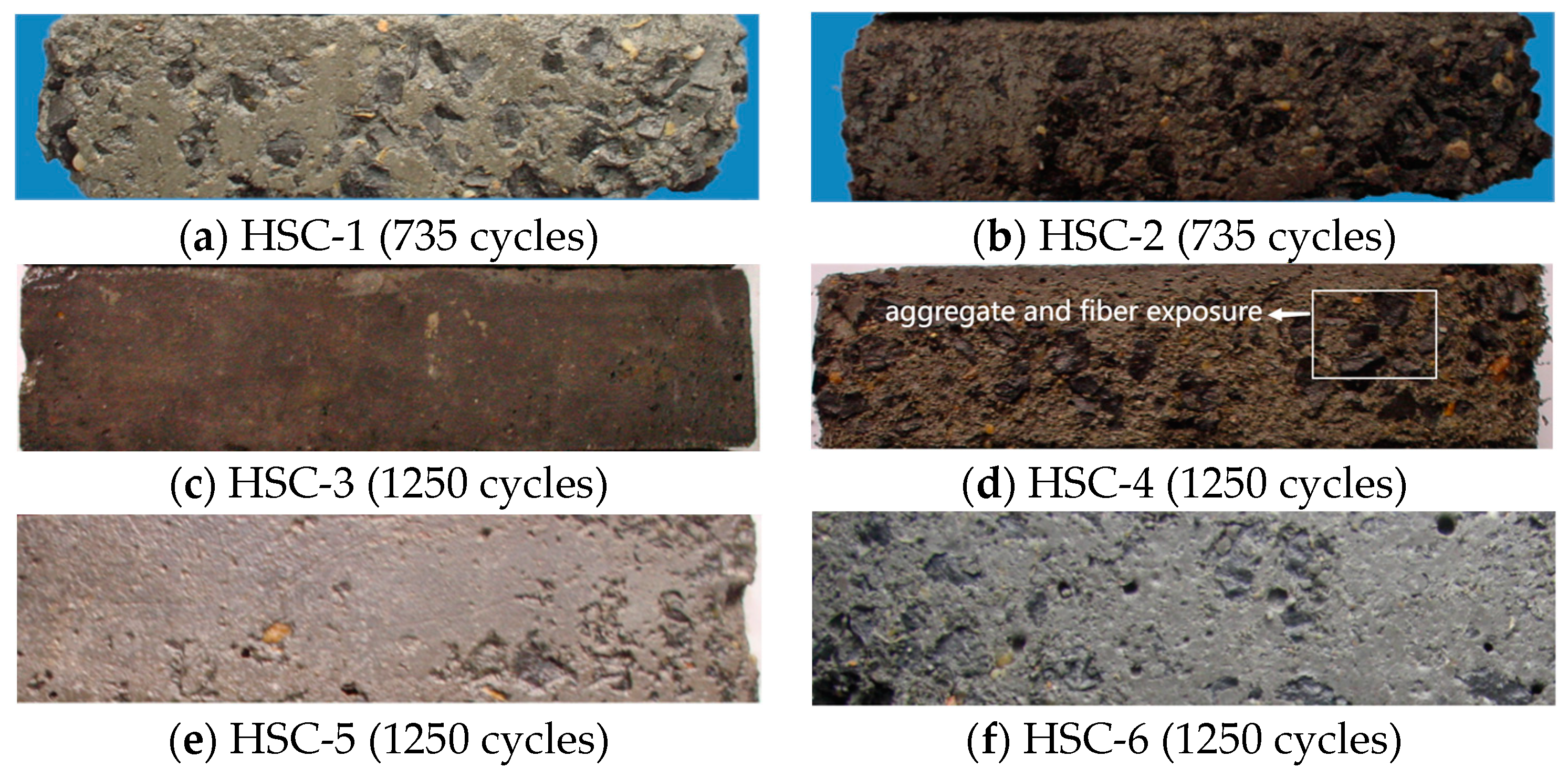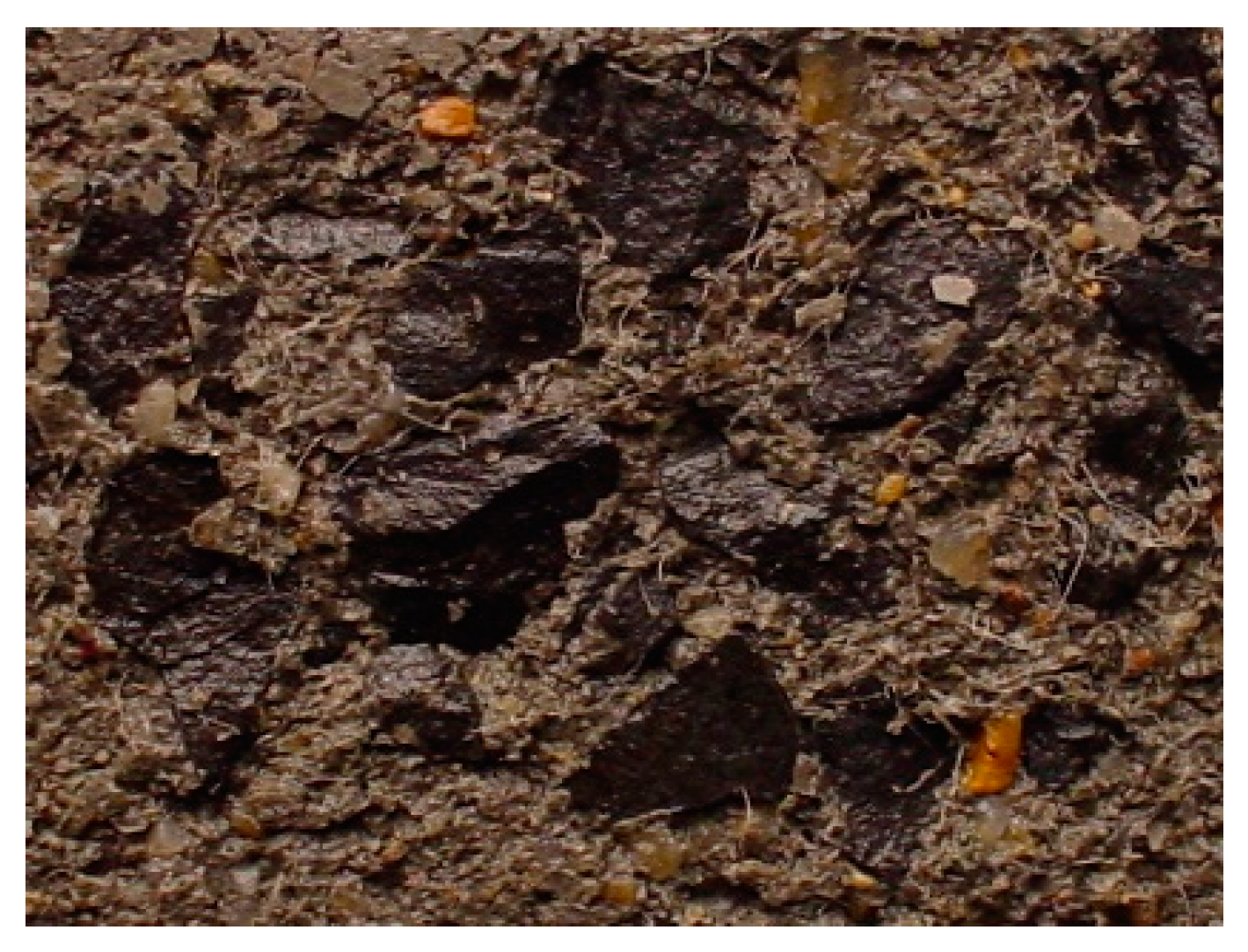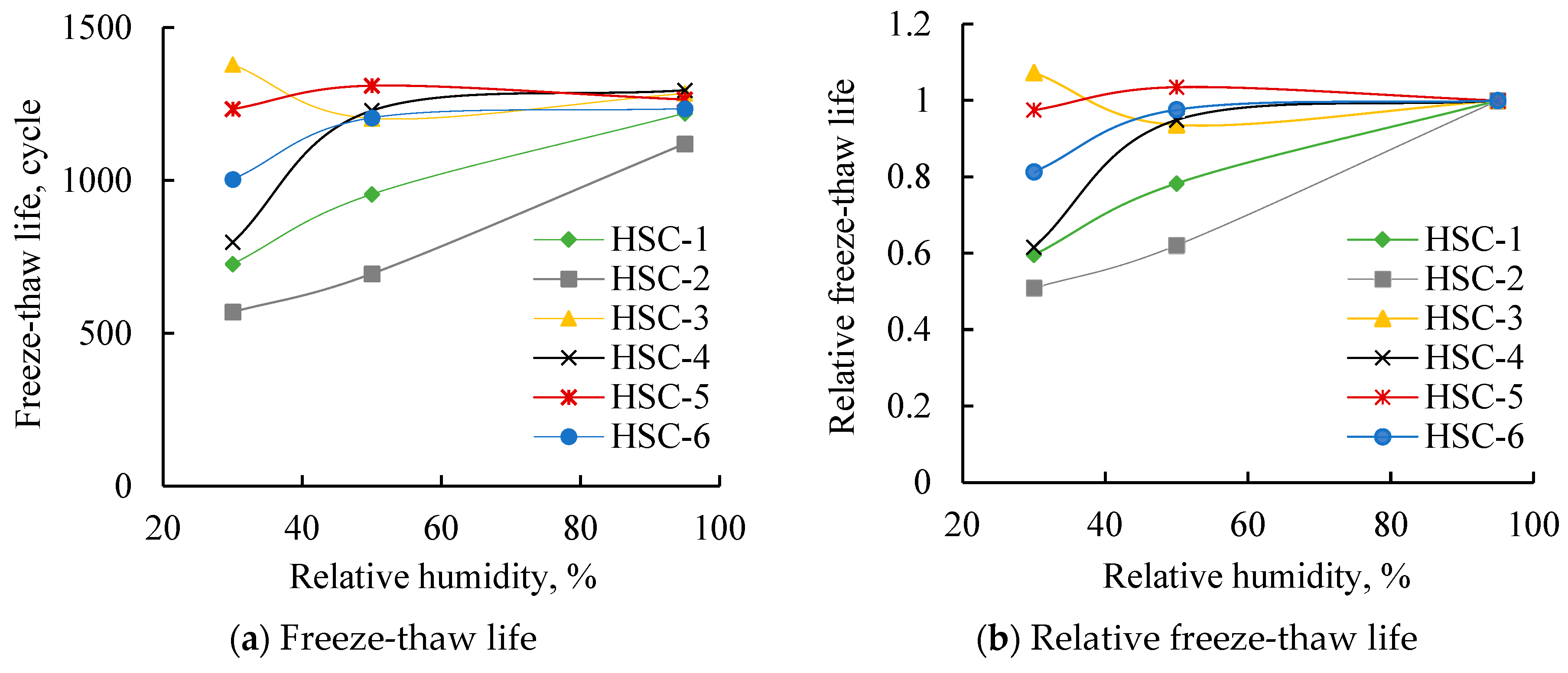Effect of Combination of Expansive Agent and Fiber on Freeze-Thaw Resistance of High-Strength Concrete at Dry Environment
Abstract
:1. Introduction
2. Raw Materials and Test Methods
2.1. Raw Materials
2.2. Mix Proportions
2.3. Test Methods
2.3.1. Specimen Preparation and Curing
2.3.2. Performance Test
3. Results and Discussion
3.1. Compressive Strength and Flexural Strength of HSC in Different RH
3.2. Freeze-Thaw Resistance of HSC and Its Relationship with Expansive Agents and Fibers
3.3. The Freeze-Thaw Resistance of HSC under Dry Conditions
3.4. Relationship between Freeze-Thaw Life of HSC and the RH of Curing Environment
4. Conclusions
Author Contributions
Funding
Institutional Review Board Statement
Informed Consent Statement
Data Availability Statement
Conflicts of Interest
References
- Bissonnette, B.; Pierre, P.; Pigeon, M. Influence of key parameters on drying shrinkage of cementitious materials. Cem. Concr. Res. 1999, 29, 1655–1662. [Google Scholar] [CrossRef]
- Barr, B.; Hoseinian, S.B.; Beygi, M.A. Shrinkage of concrete stored in natural environments. Cem. Concr. Compos. 2003, 25, 19–29. [Google Scholar] [CrossRef]
- Ye, Q.; Kong, D.Y.; Wang, J.D. Research on compensating shrinkage of high strength concrete incorporated with expansive admixture. J. Zhejiang Univ. Technol. 2000, 28, 314–318. (In Chinese) [Google Scholar]
- Tazawa, E.; Miyazawa, S. Influence of cement and admixture on autogenous shrinkage of cement paste. Cem. Concr. Res. 1995, 25, 281–287. [Google Scholar] [CrossRef]
- Sun, W.; Chen, H.S.; Luo, X.; Qian, H. The effect of hybrid fibers and expansive agent on the shrinkage and permeability of high-performance concrete. Cem. Concr. Res. 2001, 31, 595–601. [Google Scholar] [CrossRef]
- Han, Y.D.; Zhang, J.; Luosun, Y.; Hao, T. Effect of Internal Curing on Internal Relative Humidity and Shrinkage of High Strength Concrete Slabs. Constr. Build. Mater. 2014, 61, 41–49. [Google Scholar] [CrossRef]
- Afroughsabet, V.; Biolzi, L.; Monteiro, P.J.M. The effect of steel and polypropylene fibers on the chloride diffusivity and drying shrinkage of high-strength concrete. Compos. Part B Eng. 2018, 139, 84–96. [Google Scholar] [CrossRef]
- Afroughsabet, V.; Geng, G.; Lin, A.; Biolzi, L.; Ostertag, C.P.; Monteiro, P.J.M. The influence of expansive cement on the mechanical, physical, and microstructural properties of hybrid-fiber-reinforced concrete. Cem. Concr. Compos. 2019, 96, 21–32. [Google Scholar] [CrossRef]
- Corinaldesi, V.; Nardinocchi, A.; Donnini, J. The influence of expansive agent on the performance of fibre reinforced cement-based composites. Constr. Build. Mater. 2015, 91, 171–179. [Google Scholar] [CrossRef]
- Pan, Z.; Zhu, Y.; Zhang, D.; Chen, N.; Yang, Y.; Cai, X. Effect of expansive agents on the workability, crack resistance and durability of shrinkage-compensating concrete with low contents of fibers. Constr. Build. Mater. 2020, 259, 119768. [Google Scholar] [CrossRef]
- Sun, J. Frost resistance characteristics of fiber concrete. J. Build. Mater. 2013, 16, 437–440. [Google Scholar]
- Kos, Ž.; Kroviakov, S.; Kryzhanovskyi, V.; Hedulian, D. Strength, Frost Resistance, and Resistance to Acid Attacks on Fiber-Reinforced Concrete for Industrial Floors and Road Pavements with Steel and Polypropylene Fibers. Materials 2022, 15, 8339. [Google Scholar] [CrossRef]
- Pogorelov, S.N.; Semenyak, G.S. Frost Resistance of the Steel Fiber Reinforced Concrete Containing Active Mineral Additives. Procedia Eng. 2016, 150, 1491–1495. [Google Scholar] [CrossRef]
- Seung, J.L. Properties on the Freeze-Thaw Resistance of High Performance Concrete using Fibers and Mineral Admixtures. Mater. Sci. Forum 2017, 893, 375–379. [Google Scholar]
- Cao, Q.; Gao, Q.; Gao, R.; Jia, J. Chloride penetration resistance and frost resistance of fiber reinforced expansive self-consolidating concrete. Constr. Build. Mater. 2018, 158, 719–727. [Google Scholar] [CrossRef]
- Mu, R.; Miao, C.; Luo, X.; Sun, W. Interaction between Loading, freeze–thaw Cycles, and Chloride Salt Attack of Concrete with and without Steel Fiber Reinforcement. Cem. Concr. Res. 2002, 32, 1061–1066. [Google Scholar] [CrossRef]
- Sun, W.; Zhang, Y.M.; Yan, H.D.; Mu, R. Damage and Damage Resistance of High Strength Concrete Under the Action of Load and Freeze-Thaw Cycles. Cem. Concr. Res. 1999, 29, 1519–1523. [Google Scholar] [CrossRef]
- GB/T 50082-2009; Standard of Test Methods for Long-Term Performance and Durability of Ordinary Concrete. China Construction Industry Press: Beijing, China, 2009.
- Ababneh, A.N. The Coupled Effect of Moisture Diffusion, Chloride Penetration and Freezing-Thawing on Concrete Durability; University of Colorado: Denver, CO, USA, 2002. [Google Scholar]
- Yu, H. Study on High Performance Concrete in Salt Lake: Durability, Mechanism and Service Life Prediction; Southeast University: Nanjing, China, 2004. (In Chinese) [Google Scholar]
- Cao, J.G.; Li, J.Y.; Lin, L.; Tian, J.T.; Guan, Y.S.; Deng, Z.G.; Li, F.; Wang, A.Q. Study on frost resistance of High Strength Concrete. J. Build. Mater. 1999, 2, 292–297. (In Chinese) [Google Scholar]
- Stark, J.; Chelouah, N. Freezing-Thawing Durability and Salt Frost Scaling of High Performance Concrete. In High Performance Concrete—Performance of Materials and Design; Feng, N., Translator; China Construction Industry Press: Beijing, China, 1998; pp. 106–112. (In Chinese) [Google Scholar]
- Romualdi, J.P.; Baston, G.B. Mechanics of crack arrest in concrete. Eng. Mech. ASCE 1963, 89, 147–672. [Google Scholar] [CrossRef]








| Sample | SiO2 | Al2O3 | CaO | MgO | SO3 | Fe2O3 | MnO | TiO2 | Na2O | K2O | I.O.L. |
|---|---|---|---|---|---|---|---|---|---|---|---|
| Cement | 20.60 | 5.03 | 65.06 | 0.55 | 2.24 | 4.38 | -- | -- | -- | -- | 1.30 |
| AEA | 19.82 | 16.62 | 28.60 | 1.58 | 26.86 | 2.66 | -- | -- | 0.32 | 0.30 | 3.02 |
| No. | Materials, kg·m−3 | W/B | JM-B | Steel Fiber | High Elasticity Module Polyethylene Fiber | Slump, mm | Air Content, % | 28-Day Compressive Strength, MPa | ||||
|---|---|---|---|---|---|---|---|---|---|---|---|---|
| Cement | AEA | Fine Aggregate | Coarse Aggregate | Water | ||||||||
| HSC-1 | 600 | 0 | 610 | 1134 | 150 | 0.25 | 3.9 | 0 | 0 | 50 | 1.9 | 45.1 |
| HSC-2 | 540 | 60 | 610 | 1134 | 150 | 0.25 | 3.9 | 0 | 0 | 45 | 1.8 | 59.3 |
| HSC-3 | 600 | 0 | 785 | 957 | 150 | 0.25 | 5.0 | 156 | 0 | 40 | 2.3 | 70.7 |
| HSC-4 | 600 | 0 | 785 | 957 | 150 | 0.25 | 6.5 | 0 | 1 | 50 | 3.1 | 62.3 |
| HSC-5 | 540 | 60 | 785 | 957 | 150 | 0.25 | 5.0 | 156 | 0 | 45 | 2.2 | 84.3 |
| HSC-6 | 540 | 60 | 785 | 957 | 150 | 0.25 | 6.5 | 0 | 1 | 45 | 3.2 | 69.1 |
| No. | Fiber Density, g·cm−3 | Fiber Diameter, mm | Fiber Length, mm | Fiber Volume Fraction, % | Fiber Spacing, mm | Fiber Number, Single m−3 | |
|---|---|---|---|---|---|---|---|
| Two-Dimensional Random Distribution | Three-Dimensional Random Distribution | ||||||
| HSC-3 | 7.8 | 0.650 | 20 | 2 | 5.10 | 5.75 | 1.9 × 104 |
| HSC-4 | 0.97 | 0.035 | 20 | 0.1 | 1.23 | 1.38 | 5.344 × 107 |
Disclaimer/Publisher’s Note: The statements, opinions and data contained in all publications are solely those of the individual author(s) and contributor(s) and not of MDPI and/or the editor(s). MDPI and/or the editor(s) disclaim responsibility for any injury to people or property resulting from any ideas, methods, instructions or products referred to in the content. |
© 2024 by the authors. Licensee MDPI, Basel, Switzerland. This article is an open access article distributed under the terms and conditions of the Creative Commons Attribution (CC BY) license (https://creativecommons.org/licenses/by/4.0/).
Share and Cite
Song, S.; Yu, H.; Ma, H. Effect of Combination of Expansive Agent and Fiber on Freeze-Thaw Resistance of High-Strength Concrete at Dry Environment. Appl. Sci. 2024, 14, 2548. https://doi.org/10.3390/app14062548
Song S, Yu H, Ma H. Effect of Combination of Expansive Agent and Fiber on Freeze-Thaw Resistance of High-Strength Concrete at Dry Environment. Applied Sciences. 2024; 14(6):2548. https://doi.org/10.3390/app14062548
Chicago/Turabian StyleSong, Shanshan, Hongfa Yu, and Haiyan Ma. 2024. "Effect of Combination of Expansive Agent and Fiber on Freeze-Thaw Resistance of High-Strength Concrete at Dry Environment" Applied Sciences 14, no. 6: 2548. https://doi.org/10.3390/app14062548




